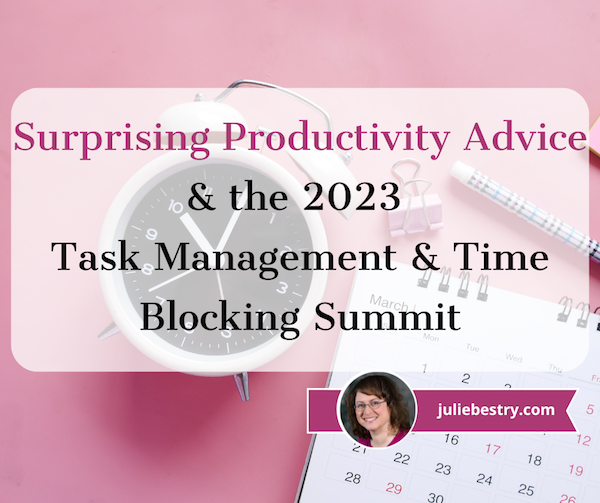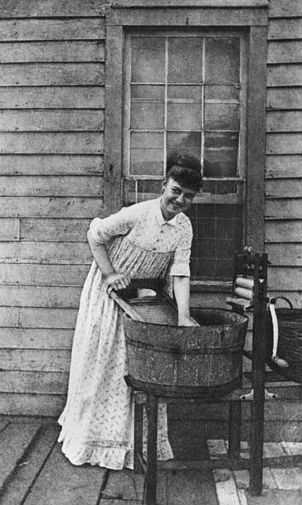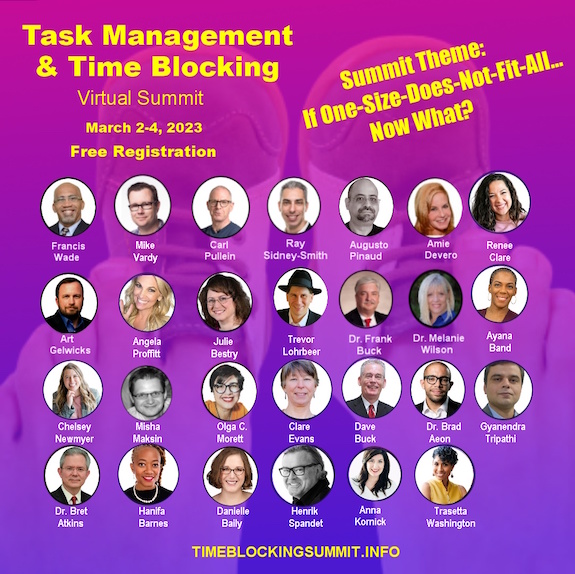Follow Me
Latest Posts
- Cool, Sustainable Packing and Shipping Solutions for Earth Day
- Paper Doll Shares How To Select a Shredder, Shred Responsibly, and Save
- Paper Doll’s Ultimate Guide to Tax-Smart Organizing: 2024
- Paper Doll Explains Aspirational vs. Inspirational Clutter
- Paper Doll Shares 3 Quirky & Cool New Office Supplies
Search Best Results Organizing
Subscribe to the Paper Doll Blog via Email
Surprising Productivity Advice & the 2023 Task Management & Time Blocking Summit
Posted on: February 27th, 2023 by Julie Bestry | 12 Comments

In fields like science, medicine, and technology, surprising information comes out all the time, and with that, novel guidance and advice. In the world of organizing and productivity, however, there aren’t a lot of unexpected, planet-sized discoveries or wrecking balls to old beliefs.
Rather, in most aspects of organizing and productivity, we seek to find novel examples and tweaks to help people understand the best approaches for what they already know deep down. Today, I’d like to share three intriguing ideas I’ve heard recently, and an opportunity for you to discover more.
WORK AS HOBBY: OVERCOME PROCRASTINATION WITH A MINDSET SHIFT
The first concept comes from my friend and colleague Hazel Thornton. You may recall her from Paper Doll Interviews the Genealogy Organizers and when I profiled her new book, Go With the Flow! The Clutter Flow Chart Workbook, in Paper Doll Presents 4 Stellar Organizing & Productivity Resources a few weeks ago.

I love Hazel’s blog, because she always offers practical yet warm insights. Earlier this month, she came up with an idea for a mindset shift for conquering procrastination, and it really got me thinking.
Usually, we approach procrastination from a practical perspective. For example, we look at how to use planning and scheduling, particularly time-blocking, to set expectations. Social science research, for example, has found that making a voting plan for when and where you will vote and how you will get there makes it more likely that you will cast a ballot.
We also look at tactical methods for getting ourselves into position to complete a task, such as using the Pomodoro Method, or enlisting accountability, as we discussed recently in Paper Doll Sees Double: Body Doubling for Productivity and Paper Doll Shares 8 Virtual Co-Working Sites to Amp Up Your Productivity.
Hazel, however, piqued my interest in suggesting something I hadn’t seen before in her post entitled Think of Your Big Project as a New Hobby. Now, I don’t want to steal Hazel’s thunder, so you should read her post in its entirety. But the basic concept is that when you find yourself procrastinating on a big project — as I recently found myself doing — a shift in mindset could ramp up your enthusiasm and make the work more appealing.
Hazel notes that the more often you do something, the easier it gets. Typically, we choose to do something repeatedly — like a hobby — because it’s fun. So, Hazel suggests approaching a project, particularly one about which you’re procrastinating, as if you were embracing a new hobby.
She notes that new hobbies usually require the acquisition of new skills and new information — just like projects do — and setting aside time to work on them. Hazel even offers a list of practical solutions (and even pointed people back to my body doubling posts — neato!) for hobby-fying a project.

If we perceive something as drudge work, we’re more likely to procrastinate on it, not set aside time to do it, and think about it as something to be avoided. We don’t get particularly excited about doing expense reports or preparing our taxes. But if we reframe a project and consider it as something that benefits us, or the people we love, or our community, if we re-set our expectations regarding how to approach something not-that-fun, our avoidance might fade away to nothing.
I think Hazel was right on the money. Over the last month, I’ve had a number of projects that were out of the ordinary for me, and one in particular involved employing technological skills that aren’t in my wheelhouse. I had to create a video (of which, more later), and as the days ticked down, I remembered my misery at completing the project last year, even though I was excited about the content. Shockingly, the video editing skills I learned in 1989-1990 in my graduate program in television production and management have very little application in 2023!
This year, I was eager to do the research and prepare my presentation, but anticipating the video production and editing was wearing me down. However, with Hazel’s blog post in mind, I started exploring ways to learn about new approaches with what Zen practitioners call, shoshin or Beginner’s Mind. It’s supposed to encourage eagerness, dispel anxiety and frustration, and yes, make procrastination less likely.
I hate being a beginner, but I psyched myself into beginnerhood for the “hobby” of making a visually-appealing, non-talking-head video. The same day I read Hazel’s post, I spoke with my accountability partner and all-around cool kitten, Dr. Melissa Gratias (whom I’ve also interviewed on the blog, in Paper Doll Interviews Melissa Gratias, Author of Seraphina Does Everything!).
Melissa had some amazing ideas that let me drop-kick PowerPoint and edit video content directly in Canva, the same platform I use to make the blog post banners at the top of every Paper Doll post. (Melissa also came to my aid every time I was stymied by an aspect of Canva that Googling didn’t solve.)
Hazel may not have realized she was channeling a key idea in Zen Buddhism, but by inspiring me to transform a hyperventilation-inducing project into one that was more hobby-like, she changed my entire outlook. I enjoy researching. I love learning new concepts. I particularly like developing skills that I can make systematic so they’re easier and easier as I do them more often. Hobbies for the win!
If you’re having trouble getting your mojo going on a project (or can envision that happening in the future), give the ideas in Hazel’s post a try.
A DIFFERENT KIND OF BACKUP
If you’ve read the Paper Doll blog for a while, you’ve probably seen me promote the importance of backup. Usually, I’m touting computer backup, such as in Paper Doll’s Ultimate Stress-Free Backup Plan.
But I’ve also looked at backing up from the perspective of human backup, such as in Cross-Training for Families: Organize for All Eventualities. Those two posts reflect both a plan for backing up, and having a backup plan for life.
However, last week I heard about a different concept for backing up that’s worth discussing. At the start of the year, in Paper Doll’s 23 Ideas for a More Organized & Productive 2023, I mentioned that I was going to be doing Laura Vanderkam‘s annual 168 Hours Time Tracking Challenge. I enjoyed it so much that I also signed up for her Tranquility by Tuesday Challenge based on her book, Tranquility By Tuesday: 9 Ways to Calm the Chaos and Make Time for What Matters. (I already knew I’d like it because she previewed the book at the 2022 Task Management and Time Blocking Virtual Summit. See below)

For each week of the challenge, Vanderkam sends emails encouraging participants to put one of her nine lessons into practice. Last week was Lesson #5: Create a Backup Slot. Here, Vanderkam talked about how even the best of intentions are not enough when we try to create a schedule that allows us to be productive and accomplish all of the things that are important to us. Most tellingly, she wrote:
I have learned that anyone can make a perfect schedule. True time management masters make a resilient schedule.
Yes! Resilience is essential! A schedule is a map of our time. With a road map, sometimes there’s a crash up ahead, or a road is washed out, or someone gets car sick. If we want to accomplish what’s important to us, we have to be prepare for unanticipated calamities.
To this end, Vanderkam advises that we not fill our schedules from morning to night (of course!) but instead designate more times in our schedules than we plan to use.

Borrowing from my cross-training approach for human backup, I might schedule Monday afternoons for writing, but cross-train Saturday so it knows how to handle the task. (OK, we’re anthropomorphizing the days of the week. Just go with it.) You might plan to do your bookkeeping on Wednesday mornings, but if an all-hands meeting gets called or you have to pick up a sick kid from school, and your Wednesday morning blows up, Thursday needs to step in as backup.
Rather than searching your schedule for places where you can either cancel something or squeeze in one more task, if you already have backup slots scheduled, you’re prepared in the eventuality of your life falling tush-over-teakettle.
Rather than searching your schedule to cancel something or squeezing in one more task, if you already have backup slots, you're prepared for when your life falls tush-over-teakettle. Click To TweetVanderkam’s approach is wise but too rarely practiced. We see blank spots in our calendars and jump to fill them, to do more, to accomplish more, to achieve more. This can be aspirational, or it can be stressful. If the latter, harken back to my posts on toxic productivity from last summer:
- Toxic Productivity In the Workplace and What Comes Next
- Toxic Productivity Part 2: How to Change Your Mindset
- Toxic Productivity Part 3: Get Off the To-Do List Hamster Wheel
- Toxic Productivity, Part 4: Find the Flip Side of Productivity Hacks
- Toxic Productivity Part 5: Technology and a Hungry Ghost
If the idea of too much empty space on your schedule makes you nervous, try just one or two slots, maybe an hour or ninety minutes, on Thursday or Friday, where you’ll be the most likely to catch up on tasks that got displaced from earlier in the week. Think about designating themed slots, like for marketing or accounting or personal development. That way, if you get to your backup slot and don’t need it, you can use it either for something within that theme, or for something fun and rejuvenating.
If you find that you’re drop-kicking things that matter to you because something blew up your schedule, adding backup slots could help you master your time and life. And Vanderkam asks, “If life went perfectly, what would you use your open time for?”
Good question. After all, why are you doing all this work in the first place?
THE WORK IS NOT ENOUGH
I read a lot of email newsletters. (Seriously. It may be an addiction.) So, to remember to read blog posts and newsletters of people whose work I’m not regularly seeing on social media, I use an RSS feed. My preferred platform is Feedly, and I can segment the blogs I read by category like entertainment, finances, productivity, tech, etc. and do a deep dive into all the posts I’ve missed over a week or month, keeping my inbox less crowded.
One of the authors I read is Anne Helen Petersen’s Culture Study. The essay that caught my eye was a fairly personal one, The Work Is Not Enough. (Note, there is one not-safe-for-work vocabulary word in the essay. Please do not click through if you are likely to be offended.)
Petersen’s post dovetailed with Vanderkam’s lesson, because, starting a few weeks ago, her life and schedule sort of blew up. Her partner was ill, her doggie was sick, it’s tax season, and there were work kerfuffles. Each thing caused the dominoes to fall:
Losing a day, an hour, an afternoon — if that was time used to put things in place to keep them rolling through the week, and that time is lost, then you find yourself in a 17-task pile-up. … and pretty soon you’re in laundry apocalypse, and the only thing that’s going to save you is […] the next weekend.
Can’t we all relate?

Petersen notes that all of the tasks, in their own version of a sort of life laundry apocalypse, could have been handled individually, but together, her mind was whirling trying to figure out which enjoyable things she should have culled to avoid the apocalypse, or could cull in the coming days to get back on track. But she recognized,
I don’t need to stop taking care of my friends’ kids, or stop running, or stop having dogs, or stop skiing in order to make this all [waves hands wildly] fall into place. I just need to be vigilant about not taking on more work than I can reconcile with the rest of my life. The work matters; the work is important; the work is wonderful. But the work is not enough.
Petersen is recognizing that often, when we have to choose what to toss from our busy schedules to get back on track, we throw ourselves overboard.
For most of us, the thing that’s easiest to jettison is the thing that’s most precious to you — because letting it go ostensibly affects you and you alone. A hobby, a personal goal, a book club, a walk, a nap, all so readily sacrificed. But those are the things that allow us to stand up straight as we carry the weight of everyday annoyances and tasks. They are the counter-balance. They are essential. We cannot mistake the ease with they can be put down with disposability.
Wow. Seriously, wow. I wish I’d had this essay to share back when I wrote the toxic productivity series, and I’m glad I can share Petersen’s wisdom here. Yes, we should develop our skills to manage our time and tasks well, but let’s not do it at the risk of what makes our lives worth living — our relationships, our joys, or our humanity.
THE 2023 TASK MANAGEMENT AND TIME BLOCKING VIRTUAL SUMMIT
For the fourth year in a row, I’m participating in Francis Wade‘s Task Management and Time Blocking Virtual Summit. Francis is a fellow Cornell University alum — we actually lived in the same international dorm — founder of 2Time Labs in Jamaica, and author of Perfect Time-Based Productivity: How To Protect Your Mind As Time Demands Increase.

In last year’s preview to the 2022 summit, I covered a lot of the reasons behind productivity struggles in Struggling To Get Things Done? Paper Doll’s Advice & The Task Management & Time Blocking Virtual Summit 2022, from external struggles like lack of structure and technology overwhelm to personal challenges and tool/user mismatches.
I recapped the gems from experts at the summit in Paper Doll Shares Secrets from the Task Management & Time Blocking Summit 2022. So, if you missed all that, basically you’ve got a tons of wisdom (theirs, as well as mine) to review.
This year’s theme absolutely delights me: One-Size-Doesn’t-Fit-All. Now what? If you ever read my post, The Truth About Celebrity Organizers, Magic Wands, and the Reality of Professional Organizing, you know how how I feel about the inadequacy of one-size-fits-all approaches to organizing and productivity.
My own presentation by pre-recorded video (about which you’ve now heard) is Paper Shame — Embracing Analog Productivity Solutions in an Increasingly Digital World. (Pssst: Melissa Gratias helped inspire the title!) I’ll also be a panelist on Saturday afternoon (because Francis has his wife/co-founder Dale know I’m not a morning person). The topic? “Paper vs. Digital.”

That panel will be moderated by friend-of-the-blog and productivity dude extraordinaire Ray Sidney-Smith. We’ll be joined by Artificial Intelligence expert, Misha Maksin.
Each year, the summit is refined and improved. This year, 27+ experts are participating, and I’m excited that I know so many of them!
On each of the three days of the summit, attendees get 24-hour access to a selection of video recordings on topics with titles like:
- Handling Multiple Projects with Ease: How To Remove the Friction and Handle the Details
- Productivity and Neurodiversity: Should I Fit in Productivity’s World or the Other Way Around?
- Mastering Productivity with Mindfulness in 5 Steps
- Build Without Burnout: Setting a Schedule for Your Business and 9-5
- What’s Really Driving Your Distractions?
- From Micro to Macro: How to Make Time Blocking Work for You
- 3 Techniques to Level Up Your Time Blocking
- Get a Game Plan: Three Steps to Designing Your Winning Week
- Why You Aren’t Achieving Your Goals: Breaking the Cookie Cutter Approach to Goal Setting
- Your Ultimate Productivity Tool: You Already Have It and It’s Not Paper or Digital
And that’s barely a third of the video options this year!
On Friday, the live portion of the TMTB Virtual Summit begins with Francis opening the event, followed by a full day of live panels and interviews. Another slew of video presentations will also be released.
I’m looking forward to Dr. Frank Buck interviewing his sort-of namesake, Dave Buck, as well as a live episode of The Productivitycast, with the aforementioned Ray, Augusto Pinaud, Art Gelwicks, and Francis. (Read more about this gang in Paper Doll Picks: Organizing and Productivity Podcasts.) I’ve been a guest on that podcast many times, and am sure it’ll be a hoot.
I’m also really excited about the panel discussion, “How Does Time Management Work Across Cultures and Countries?” and the interview with Mike Vardy about The Productivity Diet.
On Saturday, there will be more video presentations released (including mine!) as well as another spate of live interviews and panels. (You’ll enjoy everything, but if you want to see my panel, it’s from 1:45 p.m. until 3 p.m. on Saturday.)
There are also oodles of bonus offers and “swag bag” items.
The whole event takes place on a very cool interactive platform called Airmeet, allowing us to interact at digital “tables” in a sort of cloud-based ballroom and attend Zoom-like lecture rooms for official events. As with previous summits, there’s time for networking with attendees and these great speakers and geeking out on productivity.

When you register for a free e-ticket to the event, you get 24-hour access to each “chunk” of videos, plus all of the live interviews, panels, and networking events in the Airmeet Lounge.
Again, attendance is free, but you’ll have to carve out time in your schedule to watch the videos — it helps that Thursday is a video-only day! — and attend the live events, which run from 9:30 a.m. to 4 p.m. on Friday and Saturday.
 If you want more time to absorb everything, you can purchase an All-Access Pass, which is basically a smörgåsbord of summit offerings and bonus extras, including:
If you want more time to absorb everything, you can purchase an All-Access Pass, which is basically a smörgåsbord of summit offerings and bonus extras, including:
- recordings of all of the pre-recorded video presentations (including mine!)
- recordings of all of the live panels, interviews, and events
- an audio or PDF copy of Francis’ book
- a 50% discount on Francis’s My Time Design Rapid Assessment program
(Be sure to pay attention to the resulting screen post-purchase so you know how to access your goodies.)
The full price for the All-Access pass is $249. But because I love you, I’ve got a super-nifty coupon link good up until the start of the summit that takes the price down to $99!
What project might you approach as if it were a hobby?
Where can you create a backup slot in your schedule?
How will you protect the elements of your schedule that give your life meaning?
Will I see you at the 2023 Task Management and Time Blocking Summit?




So many wonderful ideas here, Julie! I love Laura Vanderkam’s phrase, “resilient schedule.” That is the essence of excellent schedule management. My calendar has color-coded time blocks indicating appointments and activities. My eye is drawn to those blocks as they help me visually “digest” at a glance what my week will be like. However, equally important is the white space. It’s essential that I have enough of that so I can move throughout my week in a calm, purposeful way. The mix between the color blocks and blank space helps make it a “resilient schedule.”
Thank you for reminding me about Hazel’s wonderful post about using the “hobby” card when we’re procrastinating on projects. Inserting the fun and curiosity factors into a project will definitely shift the focus and mindset. Being I have several projects I’ve been delaying, I’m going to test out Hazel’s strategy.
Congratulations on pushing through with your video for the TMTB Virtual Summit and for being a speaker and panelist again…4th year in a row! Way to go, Julie! You’ll be a welcome addition to the party.
Linda, I’ve found that almost all of the best-selling productivity books are written by men, and with the exception of Atomic Habits, really FOR men, with little acknowledgement of someone needing to do more than work-for-money work and possibly exercise, with no recognizing for the nuanced, busy lives of most women, often members of a sandwich generation. Laura is the exception, and her ideas are really refreshing, the resilient scheduling being just one aspect.
Thanks for your kind words, and whether you attend or not, be assured that there will be a summit recap in the very near future!
I think the thought that is really resonating this morning is the idea of our personal lives/goals/desires/hobbies/needs being the counterweight that allows us to stand straight as we bear the “outside of us” weights.
Typically, I think of the world’s burdens as being above me, bearing down vertically upon me. But this image challenges me. It shows them weighing me down on one side, which necessitates my actively adding weight to the other side. What a powerful visual to use when explaining why we shouldn’t just jettison our personal needs when the time gets tight.
The summit looks it will be amazing. I also loved Hazel’s re-framing of challenges as hobbies – super helpful. I think the key for me to making this work is having enough time.
Finally, how glad am I that I don’t have to crank laundry in a bucket LOL!
LOL, the laundry picture is a constant reminder to me (and to my clients) that we spend so much more energy on avoiding tasks than just doing them, even tasks that our fore-mothers would be agog at how easily they can be accomplished now.
I hope you’ll take a look at the summit, and that you’ll find more time for the “hobbies” of work you can now embrace.
I loved reading about how my “Think of Your Big Project as a New Hobby” post helped you to create your video without hyperventilating! And now I can’t wait to tell a particular client about backup slots. I have been known to schedule more work sessions than I might need if there was a deadline and I was worried about getting to it or how long it would take. And, for example, I will often schedule a question on a Sunday like “Ready for Presentation Wednesday?” because if I’m not ready yet, Sunday is usually a good time for me to catch up. And I have recommended time blocking and not-overscheduling to clients, but not specifically scheduling backup slots. Love it!
Yay! I bet Laura would be happy that something she wrote will help your client, and I’m happy that you’re happy that you helped me with my project. Huzzah!
Julie, I wish I could attend the summit. I’m taking a mini-vacation and visiting my brother and sister-in-law in South Carolina this weekend.
I loved reading about Ann Peterson’s essay and Laura Vanderkam’s time resilience. I also loved your thoughts on personifying days of the week. What an interesting concept.
And then there’s Hazel’s idea of making a project into a hobby. Such great ideas all woven together seamlessly.
Enjoy your vacation, Diane. And I loved that I was able to find these three concepts from three very disparate blogs, as Hazel, Laura, and Anne’s ideas really dovetailed nicely with the concepts we’ll be looking at during the summit. And remember, it’s available live *and* Memorex. 😉
Such a great informational post. I love that you remind people that it’s important to focus not just on work, but on the things we love and the idea between ease of putting a task aside and disposability is incredibly important.
Thanks, Janet. It was really uplifting to find three great posts — Hazel’s on seeing work/projects more like enjoyable life, and Laura and Anne’s about remembering why we’re doing nit all — as a tie-in to the summit. I love it when a theme comes together!
I love this: “I have learned that anyone can make a perfect schedule. True time management masters make a resilient schedule.”
We often think about resiliency when it comes to our physical or mental well-being. Why not apply it to our calendars as well. Such a great perspective. Anything that’s too complex will be hard to keep up with. That includes our schedules. Thanks for sharing that quote.
And kudos on being a presenter at the Summit for the 4th year in a row!
It’s a phenomenal experience — so many productivity experts in one space for three days! And yes, resiliency is going to be the key.